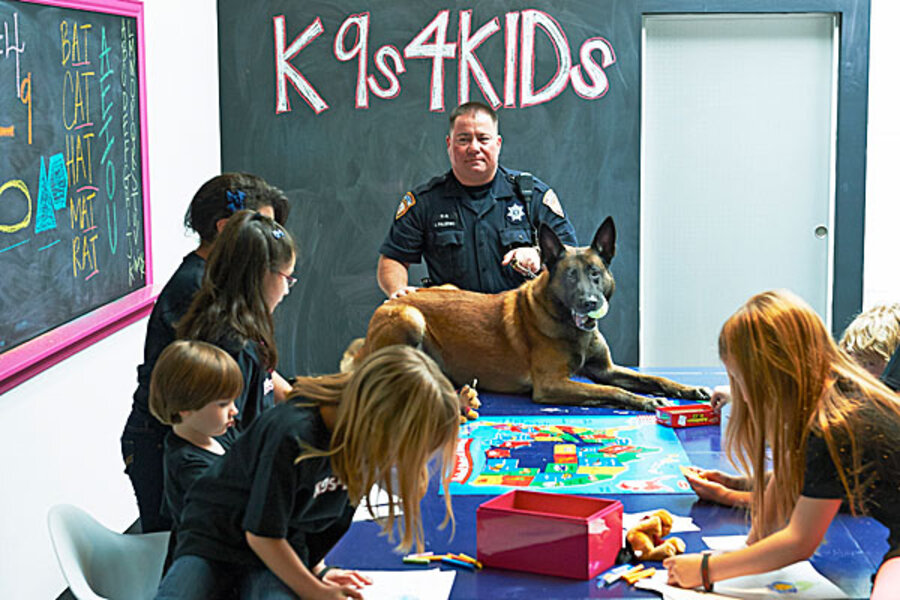School safety: Use guard dogs, not guns?
Loading...
| Los Angeles
While some say school safety hinges on guns, cameras or alarms in classrooms, Mark Gomer and Kristi Schiller think specially trained dogs should take point in preventing violence in schools.
Gomer's for-profit company has sent a gun- and drug-detecting dog to patrol the halls of an Ohio high school, while Schiller is launching a nonprofit in Houston to give schools the trained canines for free. Their programs are still in their infancy, so questions remain about dogs that can distract, scare or send kids into sneezing fits. But they think they can cultivate their ideas to help schools across the country stay safe.
Gomer's first full-time safety dog is a year-old Dutch shepherd named Atticus, who reported to duty this school year at Oak Hills High School in Green Township in southwest Ohio.
The dog trained at the school before the summer break, said Gomer, co-owner of American Success Dog Training in Bridgetown, Ohio. As part of the company's School Protection Dog program, Atticus learned on the job about marching bands and school bells and the thunk of books hitting a locker.
Gomer, who has trained about 8,000 dogs over 20 years and has three children in the school district, suggested the dog after 20 students and six teachers were killed at Sandy Hook Elementary School in Newtown, Conn.
Atticus has won over students, parents, teachers and district Superintendent Todd Yohey, who initially worried what people would think of him spending $10,000 on a dog.
Gomer has talked to a lot of parents and faculty, and they are saying it was money well-spent, he said.
Atticus spends his days on a leash with two security guards and goes home with Principal John Stoddard at night. Messages left for Stoddard were not immediately returned.
For her part, Schiller is looking to provide safety dogs to schools free of charge. She hopes her new initiative, K9s4KIDs, does for schools what her K9s4COPs did for police departments. She has placed more than 60 dogs with agencies in three years.
"These canines are extremely social, yet highly qualified warriors that are accustomed to going straight to the source of a threat or shooter and disengaging the suspect armed with the weapon," said Schiller, a Houston mother and philanthropist.
The idea for K9s4KIDs grew out of school shootings and suggestions on applications for police dogs, she said.
"Something that came up was the lack of campus police or sufficient support for the law enforcement agencies that responded," Schiller said.
If a school applies for and is chosen to receive a dog, it will come fully trained and paid for. Buying and training a safety dog costs between $10,000 and $15,000, she said.
Schiller said it would be up to school officials to decide who will handle the dogs, what they will be trained to search for, and if a dog will be assigned to one school or several in a district.
Schools will also have to consider the expense of providing medical care, food, a home and handler for the dog.
As the programs get up and running, questions remain about possible health problems and distractions the dogs can cause.
But Gomer said that fear and allergies are nothing new. He said police departments have been bringing dogs into schools for years, and some children with disabilities use them, too.
"If a child is allergic or extremely fearful, the (safety) dog will steer clear," he said.
A school safety expert said those are concerns parents and schools will have to work out. Ken Trump, president of the Cleveland-based National School Safety and Security Services consulting firm, discussed the issue in general because he was not familiar with either program.
He said the dogs would have to be extremely social to deal with students' initial excitement.
"Kids are going to be all over those dogs," Trump said. "There are concerns to work around, but with the right dogs and right handlers and the right policies and procedures, they should be very beneficial."
He said the dogs encountering a gunman would be a benefit, but the relationships the kids build with the dogs and handlers and the sense of well-being they create will probably be more lasting and life-changing.
The dogs might be a distraction in the beginning, but they will become part of what students expect to see when they go to school, Trump said.
"There is so much these dogs can do, and they're always coming up with new ideas," said Ted Dahlin, a Harris County, Texas, constable's deputy who serves on the K9s4COPs board of directors. "If I were going to pick a school to make trouble, it would be one I knew didn't have a dog."
Copyright 2013 The Associated Press. All rights reserved. This material may not be published, broadcast, rewritten or redistributed.







